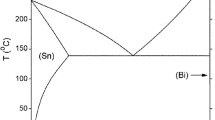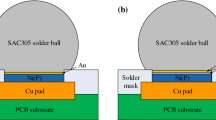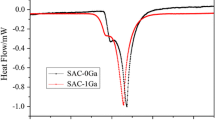Abstract
In this paper, we proposed a method of strengthening Sn-based solder to retard the microstructural evolution during thermal cycling and thus to improve the thermal fatigue life of Sn-based solder joint. We fabricated a multiple-elemental Sn-based solder by adding Ni, Bi and Sb into the Sn3.0%Ag0.5%Cu (SAC305) solder. Thermal cycling tests (− 55 °C ~ 150 °C) were performed on the prepared multiple-elemental Sn-based solder joints and SAC305 solder joints, and quasi-in situ observation was accompanied by the thermal cycling test to identify and compare the corresponding microstructural evolution process. It turned out that the intragranular dislocation movements were effectively hindered at the early stage of thermal cycling, which was due to the effects of solid solution strengthening. Furthermore, the motion of pre-existing grain boundaries and hysteresis of dislocation slip played a predominated role in the strengthened multiple-elemental solder joints. By contrast, the aforementioned two phenomena occurred concurrently in the non-strengthened solder joints. As a consequence, the multiple-elemental solder joints retained the integrity of solder joints after 1200 thermal cycles. This phenomenon indicates that the microstructural evolution was significantly delayed compared with the pristine SAC305 solder joints during thermal cycling. Therefore, SACNSB solder joints have a longer thermal fatigue life. The idea of retarding microstructure evolution during thermal cycling by strengthening Sn matrix can help open a new pathway to improve thermal fatigue life of Sn-based solder joints.











Similar content being viewed by others
Data availability
The data that support all plots within this paper are available from the corresponding author upon reasonable request.
References
Lai Y, Chen S, Ren X et al (2022) Growth behavior and morphology evolution of interfacial (Cu, Ni)6Sn5 in (001)Cu/Sn/Ni micro solder joints. Mater Charact 186:111803. https://doi.org/10.1016/j.matchar.2022.111803
Tao QB, Benabou L, Van Nguyen TA, Nguyen-Xuan H (2019) Isothermal aging and shear creep behavior of a novel lead-free solder joint with small additions of Bi, Sb and Ni. J Alloys Compd 789:183–192. https://doi.org/10.1016/j.jallcom.2019.02.316
Teo JWR, Sun YF (2008) Spalling behavior of interfacial intermetallic compounds in Pb-free solder joints subjected to temperature cycling loading. Acta Mater 56:242–249. https://doi.org/10.1016/j.actamat.2007.09.026
Liu Y, Pu L, Yang Y et al (2020) A high-entropy alloy as very low melting point solder for advanced electronic packaging. Mater Today Adv 7:100101. https://doi.org/10.1016/j.mtadv.2020.100101
George E, Osterman M, Pecht M, Coyle R, Parker R (2014) Thermal cycling reliability of alternative low-silver tin-based solders. J Microelectron Electron Packag 11:137–145. https://doi.org/10.4071/imaps.424
Coyle RJ, Sweatman K, Arfaei B (2015) Thermal fatigue evaluation of pb-free solder joints: results, lessons learned, and future trends. JOM 67:2394–2415. https://doi.org/10.1007/s11837-015-1595-1
Libot JB, Alexis J, Dalverny O et al (2018) Microstructural evolutions of Sn-3.0Ag-0.5Cu solder joints during thermal cycling. Microelectron Reliab 83:64–76. https://doi.org/10.1016/j.microrel.2018.02.009
Ma ZL, Belyakov SA, Sweatman K et al (2017) Harnessing heterogeneous nucleation to control tin orientations in electronic interconnections. Nat Commun 8:1916. https://doi.org/10.1038/s41467-017-01727-6
Cheng F, Nishikawa H, Takemoto T (2008) Microstructural and mechanical properties of Sn–Ag–Cu lead-free solders with minor addition of Ni and/or Co. J Mater Sci 43:3643–3648. https://doi.org/10.1007/s10853-008-2580-7
Du Y, Wang Y, Ji X et al (2022) Impact of Ni-coated carbon fiber on the interfacial (Cu, Ni)6Sn5 growth of Sn-3.5Ag composite solder on Cu substrate during reflow and isothermal aging. Mater Today Commun 31:103572. https://doi.org/10.1016/j.mtcomm.2022.103572
Liu Y, Sun F, Liu Y, Li X (2014) Effect of Ni, Bi concentration on the microstructure and shear behavior of low-Ag SAC–Bi–Ni/Cu solder joints. J Mater Sci Mater Electron 25:2627–2633. https://doi.org/10.1007/s10854-014-1921-3
Peng C, Shen J, Yin H (2013) Influences of ZrO2 nano-particles on the microstructures and microhardness of Sn8Zn1Bi–xZrO2/Cu solder joints. J Mater Sci Mater Electron 24:203–210. https://doi.org/10.1007/s10854-012-0711-z
Shalaby RM, Elzanaty H (2020) Effect of nano-Al2O3 particles on the microstructure and mechanical performance of melt-spun process Sn–3.5Ag composite solder. J Mater Sci Mater Electron 31:5907–5913. https://doi.org/10.1007/s10854-019-02821-9
Tao QB, Benabou L, Vivet L, Le VN, Ouezdou FB (2016) Effect of Ni and Sb additions and testing conditions on the mechanical properties and microstructures of lead-free solder joints. Mater Sci Eng Struct Mater Prop Misrostruct Process 669:403–416. https://doi.org/10.1016/j.msea.2016.05.102
Xiuchen Z, Yanni W, Yi Li, Ying L, Yong W (2016) Effect of γ- Fe2O3 nanoparticles size on the properties of Sn-1.0Age0.5Cu nano-composite solders and joints. J Alloys Compd 662:272–282. https://doi.org/10.1016/j.jallcom.2015.11.213
Wierzbicka-Miernik A, Miernik K, Filipek R, Szyszkiewicz K (2017) Kinetics of intermetallic phase growth and determination of diffusion coefficients in solid–solid-state reaction between Cu and (Sn+1at.%Ni) pads. J Mater Sci 52:10533–10544. https://doi.org/10.1007/s10853-017-1187-2
Maurice N, Collins, et al (2016) Microstructural influences on thermomechanical fatigue behaviour of third generation high Ag content Pb-Free solder alloys. J Alloys Compd 688:164–170. https://doi.org/10.1016/j.jallcom.2016.07.191
Hamasha SD, Akkara F, Abueed M, et al (2018) Effect of surface finish and high bi solder alloy on component reliability in thermal cycling. In: 2018 IEEE 68th electronic components and technology conference (ECTC): 2032–2040
Li F, Verdingovas V, Dirscherl K et al (2020) Influence of Ni, Bi, and Sb additives on the microstructure and the corrosion behavior of Sn–Ag–Cu solder alloys. J Mater Sci: Mater Electron 31(18):15308–15321. https://doi.org/10.1007/s10854-020-04095-y
El-Daly AA, El-Taher AM, Gouda S (2015) Development of new multicomponent Sn–Ag–Cu–Bi lead-free solders for low-cost commercial electronic assembly. J Alloy Compd 627:268–275
El-Daly AA, Swilem Y, Hammad EA (2008) Influences of Ag and Au additions on structure and tensile strength of Sn-5Sb lead free solder alloy. J Mater Sci Technol 6:921–925. https://doi.org/10.1016/S1006-706X(08)60273-3
Mahmudi R, Mahin-Shirazi S (2011) Effect of Sb addition on the tensile deformation behavior of lead-free Sn–3.5Ag solder alloy. Mater Design 32(10):5027–5032. https://doi.org/10.1016/j.matdes.2011.05.052
El-Daly AA, Hammad AE, Fawzy A et al (2013) Microstructure, mechanical properties, and deformation behavior of Sn–1.0Ag–0.5Cu solder after Ni and Sb additions. Mater Design 43:40–49. https://doi.org/10.1016/j.matdes.2012.06.058
Chen BL, Li GY (2004) Influence of Sb on IMC growth in Sn–Ag–Cu–Sb Pb-free solder joints in reflow process. Thin Solid Films 462:395–401. https://doi.org/10.1016/j.tsf.2004.05.063
El-Daly AA, El-Taher AM, Dalloul TR (2014) Improved creep resistance and thermal behavior of Ni-doped Sn–3.0Ag–0.5Cu lead-free solder. J Alloys Compd 587:32–39. https://doi.org/10.1016/j.jallcom.2013.10.148
Hammad AE (2013) Investigation of microstructure and mechanical properties of novel Sn–0.5Ag–0.7Cu solders containing small amount of Ni. Mater Design 50:108–116. https://doi.org/10.1016/j.matdes.2013.03.010
Han J, Guo F, Liu JP (2017) Early stages of localized recrystallization in Pb-free BGA 18 solder joints subjected to thermomechanical stress. J Alloys and Compd 19:574–584. https://doi.org/10.1016/j.jallcom.2017.02.090
Thomas RB, Zhou B et al (2012) The role of elastic and plastic anisotropy of Sn on recrystallization and damage evolution during thermal cycling in SAC305 solder joints. J Electron Mater 41(2):283–301. https://doi.org/10.1007/s11664-011-1811-x
Chen H, Mueller M, Mattila TT et al (2011) Localized recrystallization and cracking of lead-free solder interconnections under thermal cycling. J Mater Res 26:2103–2116
Henderson DW, Woods JJ et al (2004) The microstructure of Sn in near-eutectic Sn–Ag–Cu alloy solder joints and its role in thermomechanical fatigue. J Mater Res 19(6):1608. https://doi.org/10.1557/JMR.2004.0222
Hokka J, Mattila TT et al (2013) Thermal cycling reliability of Sn-Ag-Cu solder interconnections. Part 1: effects of test parameters. J Electron Mater 42(6):1171–1183. https://doi.org/10.1007/s11664-013-2551-x
Sona M, Prabhu KN (2013) Review on microstructure evolution in Sn–Ag–Cu solders and its effect on mechanical integrity of solder joints. J Mater Sci Mater Electron 24:3149–3169. https://doi.org/10.1007/s10854-013-1240-0
Matin MA, Vellinga WP, Geers MGD (2006) Microstructure evolution in a Pb-free solder alloy during mechanical fatigue. Mater Sci Eng A 431:166–174. https://doi.org/10.1016/j.msea.2006.05.144
Telang AU, Bieler TR, Zamiri A, Pourboghrat F (2007) Incremental recrystallization/grain growth driven by elastic strain energy release in a thermomechanically fatigued lead-free solder joint. Acta Mater 55:2265–2277. https://doi.org/10.1016/j.actamat.2006.11.023
Ji X, An R, Zhou W et al (2022) Revealing the ductile-to-brittle transition mechanism in polycrystalline body-centered tetragonal tin (Sn) for cryogenic electronics. J Alloys Compd 903:163948. https://doi.org/10.1016/j.jallcom.2022.163948
Zhou B, Bieler TR, Lee T-K, Liu K-C (2009) Methodology for analyzing slip behavior in ball grid array lead-free solder joints after simple shear. J Electron Mater 38:2702. https://doi.org/10.1007/s11664-009-0929-6
Zhou B, Zhou Q, Bieler TR, Lee T (2015) Slip, crystal orientation, and damage evolution during thermal cycling in high-strain wafer-level chip-scale packages. J Electron Mater 44:895–908. https://doi.org/10.1007/s11664-014-3572-9
Lee T-K (2014) Fundamentals of lead-free solder interconnect technology: from microstructures to reliability. Springer, New York
Tan S, Han J, Guo F (2018) Recrystallization behavior in mixed solder joints of BGA components during thermal shock. J Electron Mater 47:4156–4164. https://doi.org/10.1007/s11664-018-6124-x
Acknowledgements
We greatly appreciate the financial support of National Natural Science Foundation of China (52001013), R&D Program of Beijing Municipal Education Commission (KZ202210005002) and Project funded by China Postdoctoral Science Foundation (2022M710271). The authors are grateful for their financial support.
Author information
Authors and Affiliations
Contributions
XW was involved in methodology, visualization, writing—original draft. XJ contributed to formal analysis, supervision, writing—review and editing. YD was involved in methodology, visualization, writing—review and editing. YW contributed to validation, supervision, project administration. FG was involved in conceptualization, writing—review and editing, funding acquisition.
Corresponding author
Ethics declarations
Conflicts of interest
The authors declare that they have no known competing financial interests or personal relationships that could have appeared to influence the work reported in this paper.
Ethical approval
This work does not involve any human tissue or bodily fluids, animal subjects, or human experiments. This manuscript has not been published in whole or in part elsewhere; this manuscript is not currently being considered for publication in another journal; all authors have been personally and actively involved in substantive work leading to the manuscript and will hold themselves jointly and individually responsible for its content.
Additional information
Handling Editor: Megumi Kawasaki.
Publisher's Note
Springer Nature remains neutral with regard to jurisdictional claims in published maps and institutional affiliations.
Rights and permissions
Springer Nature or its licensor (e.g. a society or other partner) holds exclusive rights to this article under a publishing agreement with the author(s) or other rightsholder(s); author self-archiving of the accepted manuscript version of this article is solely governed by the terms of such publishing agreement and applicable law.
About this article
Cite this article
Wang, X., Ji, X., Du, Y. et al. Retarding microstructural evolution of multiple-elemental SnAgCu solder joints during thermal cycling by strengthening Sn matrix. J Mater Sci 58, 4199–4212 (2023). https://doi.org/10.1007/s10853-023-08280-2
Received:
Accepted:
Published:
Issue Date:
DOI: https://doi.org/10.1007/s10853-023-08280-2




